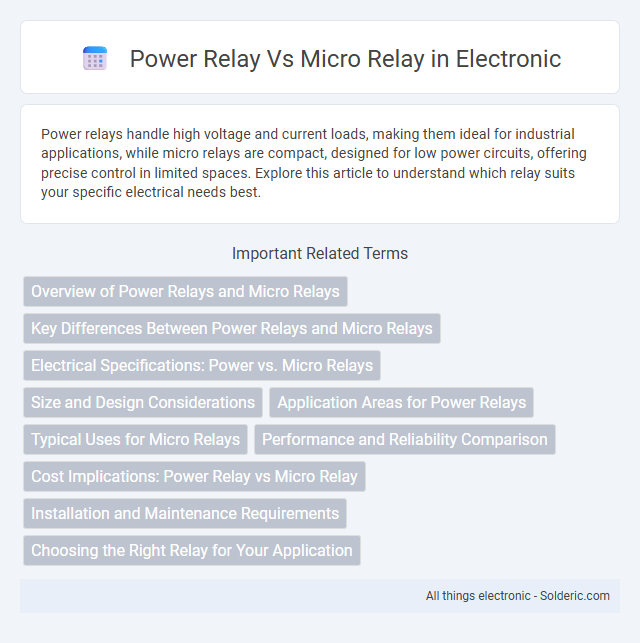Power relays handle high voltage and current loads, making them ideal for industrial applications, while micro relays are compact, designed for low power circuits, offering precise control in limited spaces. Explore this article to understand which relay suits your specific electrical needs best.
Comparison Table
| Feature | Power Relay | Micro Relay |
|---|---|---|
| Size | Large, bulky | Compact, small footprint |
| Current Rating | High (up to hundreds of Amps) | Low to moderate (up to a few Amps) |
| Application | Industrial, heavy machinery, power circuits | Electronics, telecommunications, control systems |
| Coil Voltage | Varies widely, often higher voltage | Low voltage, often 5V, 12V, or 24V |
| Switching Speed | Slower, mechanical delay | Faster, suitable for quick switching |
| Durability | High mechanical endurance, robust | Moderate endurance, designed for lighter use |
| Cost | Generally higher due to size and capacity | Lower, cost-effective for small loads |
Overview of Power Relays and Micro Relays
Power relays are electromechanical switches designed to handle high current loads, often exceeding 10 amps, making them suitable for industrial machinery, automotive applications, and HVAC systems. Micro relays, also known as signal relays, operate at much lower currents, typically below 2 amps, and are ideal for telecommunications, instrumentation, and control circuits requiring compact size and precise switching. Both relay types utilize electromagnetic coils to open or close contacts, but their differences in size, current capacity, and switching speed define their distinct applications.
Key Differences Between Power Relays and Micro Relays
Power relays handle higher current loads, typically ranging from 10 to 100 amperes, and are used in industrial machinery and heavy-duty electrical equipment. Micro relays are designed for low current applications, usually below 5 amperes, offering compact size and precise switching for electronics and telecommunications. The key differences lie in their current capacity, physical size, and application scope, with power relays emphasizing robustness and micro relays prioritizing miniaturization and efficiency.
Electrical Specifications: Power vs. Micro Relays
Power relays handle higher current loads, typically ranging from 10A to over 100A, making them suitable for industrial and heavy-duty applications. Micro relays, in contrast, operate at lower currents between 1A and 10A, ideal for compact electronic devices with limited space and lower power requirements. Your choice depends on the electrical specifications of the application, ensuring optimal performance and reliability based on current and voltage demands.
Size and Design Considerations
Power relays typically feature larger sizes and robust designs to handle high current loads, making them suitable for industrial applications. Micro relays, by contrast, are compact with intricate designs tailored for low-power and space-constrained environments such as telecommunications and consumer electronics. The choice between the two depends heavily on circuit requirements, including current rating and physical space limitations.
Application Areas for Power Relays
Power relays are primarily used in industrial automation, motor control, HVAC systems, and power distribution due to their capability to handle high voltage and current loads. These relays provide reliable switching for heavy machinery, lighting systems, and electrical panels in manufacturing plants and commercial buildings. Their robust design makes them suitable for applications requiring frequent switching and high durability under harsh environmental conditions.
Typical Uses for Micro Relays
Micro relays are commonly used in applications requiring low power control, such as telecommunications, HVAC systems, and instrumentation due to their compact size and precise switching capabilities. They are ideal for signal switching in devices with limited space, providing reliable performance in consumer electronics and automotive systems. Your designs benefit from micro relays when small footprint and fast, low-current switching are critical factors.
Performance and Reliability Comparison
Power relays offer higher current handling capabilities and robust mechanical durability, making them suitable for heavy-duty industrial applications requiring reliable switching under high loads. Micro relays provide faster response times and lower power consumption, ideal for precision electronics and compact devices where space and efficiency are critical. When selecting a relay, consider your system's load requirements and operational frequency to ensure optimal performance and long-term reliability.
Cost Implications: Power Relay vs Micro Relay
Power relays typically have higher upfront costs due to their larger size and capacity, but they offer greater durability and can handle higher current loads, which may reduce long-term maintenance expenses. Micro relays are more cost-effective for applications requiring low power switching and compact design, often resulting in savings on installation space and energy consumption. Your choice between power relay vs micro relay should consider both initial investment and operational cost efficiency relative to your specific electrical requirements.
Installation and Maintenance Requirements
Power relays typically require more robust mounting solutions due to their larger size and higher current handling capabilities, often necessitating specialized sockets or panel installations. Micro relays, being compact and lightweight, allow for easier installation on printed circuit boards with standard socket options, reducing space and simplifying wiring complexity. Your choice between power and micro relays should consider the ease of maintenance, with micro relays generally offering quicker replacement and lower downtime due to their modular design.
Choosing the Right Relay for Your Application
Choosing the right relay for your application depends on the load requirements and space constraints. Power relays are ideal for handling high current and voltage, making them suitable for heavy-duty industrial equipment, while micro relays offer compact size and fast switching capabilities for electronic circuits and automation systems. Understanding these factors ensures that your relay choice maximizes efficiency and reliability in your project.
Power relay vs micro relay Infographic

 solderic.com
solderic.com